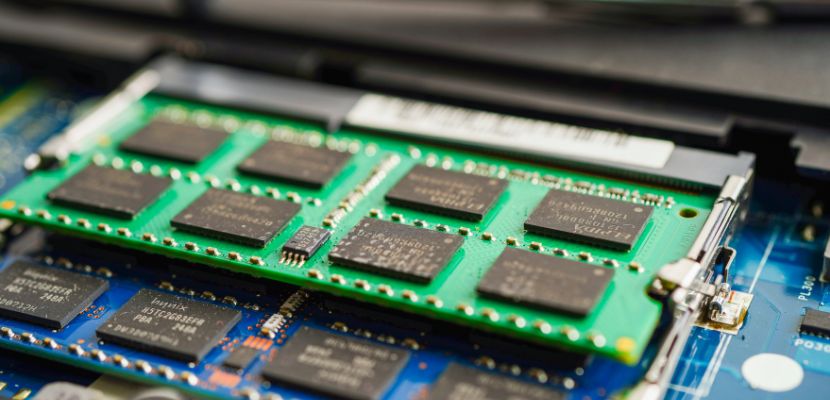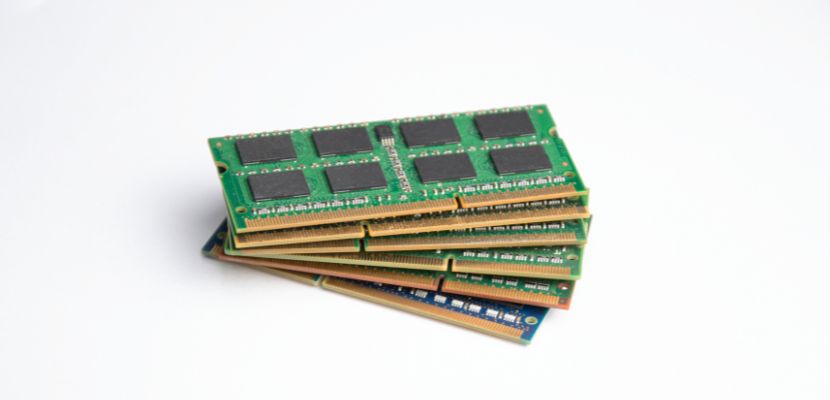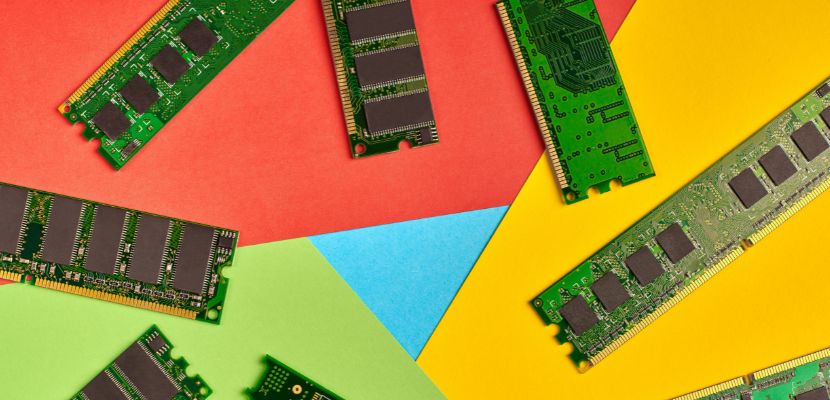A RAM slot, also known as a memory slot, is a physical connector on a computer’s motherboard designed to hold RAM (Random Access Memory) modules.

What Is a RAM Slot?
A RAM slot, or memory slot, is a socket on a computer motherboard that allows for the installation of RAM modules, enabling the system to store and quickly access data needed for active tasks. It provides the electrical and physical interface between the RAM and the motherboard, facilitating high-speed data transfer to and from the system’s central processing unit (CPU).
Each slot is designed to accommodate a specific type of RAM, such as DDR3, DDR4, or DDR5, with notches and pin configurations that prevent incompatible modules from being inserted. The number of RAM slots on a motherboard varies depending on the form factor and design, with more slots allowing for higher memory capacity and more flexible upgrade options. RAM slots operate in coordination with the system’s memory controller to support functions such as dual-channel or quad-channel memory configurations, which enhance overall system performance.
RAM Slot Architecture
Each RAM slot is a long, narrow connector with a set of metal contacts that align with the pins on a RAM module. These contacts are responsible for transmitting data, address, and control signals between the RAM and the memory controller. The slots are keyed with notches to ensure correct module orientation and prevent insertion of incompatible RAM types.
Slots are typically organized in channels—such as single, dual, triple, or quad-channel configurations—where each channel corresponds to a set of slots that can access memory concurrently. This design allows for increased memory bandwidth when identical modules are installed in matching channels. The slots are also electrically connected to the CPU’s memory controller via the motherboard’s traces, which are carefully engineered to maintain signal integrity and minimize latency.
Motherboards specify which RAM standards they support (e.g., DDR4 or DDR5), and the RAM slot architecture must match these in terms of voltage levels, data bus width, and timing characteristics. In modern systems, each slot supports high-speed, low-voltage operation and may include additional features such as error checking (ECC) or buffered signaling in enterprise environments.
RAM Slot Types

RAM slot types refer to the different designs and specifications of memory sockets found on motherboards, each corresponding to a particular generation and form factor of RAM. The most common slot type in modern desktops is the DIMM (dual inline memory module) slot, while laptops typically use SO-DIMM (small outline DIMM) slots, which are shorter to save space.
Each RAM slot type is designed to support a specific DDR (double data rate) memory generation—such as DDR, DDR2, DDR3, DDR4, or DDR5. These types are not interchangeable due to differences in voltage, speed, pin configuration, and physical keying. For example, a DDR4 module will not fit into a DDR3 slot because the notch placement and electrical requirements differ.
Server and workstation motherboards may use specialized slot types to support ECC memory or registered/buffered modules, which offer improved stability and error handling. Additionally, the number of RAM slots and their channel configuration (single, dual, or quad) depends on the motherboard architecture, influencing overall memory capacity and performance.
What Is a RAM Slot Used For?
A RAM slot is used to install memory modules into a computer system, allowing the motherboard to access the memory needed for processing data and running applications. It serves as the physical and electrical interface between the RAM and the system’s memory controller, enabling high-speed communication between the CPU and active memory. By adding RAM modules to available slots, users can increase the system’s memory capacity, improve multitasking performance, and support memory-intensive workloads such as gaming, video editing, or large-scale data processing.
How to Use a RAM Slot for Optimal Performance?
To use a RAM slot for optimal performance, install memory modules according to the motherboard’s channel configuration and compatibility requirements. Most modern systems support dual-channel or quad-channel memory architectures, which require pairing RAM sticks in specific slots to maximize bandwidth. Always consult the motherboard manual to determine the correct slot order—typically, matched pairs should be installed in the same-colored slots or in slots labeled A1 and B1 first.
Use identical RAM modules in terms of capacity, speed, and latency to ensure stability and avoid performance bottlenecks. If mixing modules is unavoidable, the system will operate at the speed and timing of the slowest module. Ensure modules are firmly seated in the slot with the latches fully locked to avoid connection issues.
Also, enable XMP (extreme memory profile) or DOCP (for AMD boards) in the BIOS/UEFI to run the RAM at its advertised speed rather than defaulting to a lower baseline. Keeping BIOS firmware up to date can also help with memory compatibility and performance tuning.
Where Are RAM Slots Located?
RAM slots are located directly on the motherboard, typically near the CPU socket. They are long, narrow connectors arranged in parallel, usually in pairs or groups of four, depending on the motherboard’s form factor and memory channel support.
On most desktop motherboards, RAM slots are positioned to the right of the CPU socket and oriented vertically, while in laptops, SO-DIMM slots are smaller and may be located on either side of the motherboard, often under a removable panel. Each slot is flanked by locking tabs that secure the RAM module in place once inserted.
How Do I Check My RAM Slot?
To check your RAM slot, you can either inspect it physically or use software tools, depending on whether you're comfortable opening your computer.
Physically, turn off your PC or laptop, unplug it, and ground yourself to avoid static damage. Open the case or access panel and locate the RAM slots on the motherboard, usually next to the CPU. You can check how many slots are present, how many are occupied, and whether the modules are properly seated.
Using software, tools like Task Manager (Windows), System Information, or third-party apps like CPU-Z can show how many RAM slots your system has, how many are in use, and details about the size, speed, and channel configuration of each module without opening the device.
What Are the Advantages and Limitations of RAM Slots?
RAM slots play a critical role in determining a system’s memory capacity, performance, and upgrade potential. Understanding their advantages and limitations helps in making informed decisions when configuring or expanding a computer’s memory setup.
RAM Slot Advantages
Here are the key advantages of RAM slots:
- Expandability. RAM slots allow users to increase a system’s memory capacity by adding more modules, enabling better performance for multitasking, gaming, and professional workloads without replacing the entire system.
- Flexibility. Multiple slots give users the option to choose different memory configurations (e.g., single-channel, dual-channel, quad-channel), allowing for performance tuning and cost-effective upgrades.
- Improved performance via channel architecture. When RAM modules are installed in matched pairs across supported channels, the system can take advantage of dual- or quad-channel memory, which increases data bandwidth and improves overall speed.
- Serviceability and upgrades. RAM slots make it easy to remove and replace memory modules for troubleshooting or upgrades, extending the useful life of the system without needing a new motherboard.
- Support for specialized memory types. Certain motherboards provide RAM slots compatible with ECC or registered memory, offering additional reliability and error correction in enterprise and server environments.
RAM Slot Limitations
RAM slot also includes some limitations:
- Limited number of slots. Most consumer motherboards have only 2 to 4 RAM slots, restricting the total amount of memory that can be installed. This can limit performance in memory-intensive applications.
- Generation compatibility. RAM slots support only specific types of RAM (e.g., DDR4 or DDR5). They are not backward- or forward-compatible, meaning you can't insert a DDR3 module into a DDR4 slot or vice versa.
- Channel configuration requirements. For optimal performance in dual- or quad-channel mode, RAM must be installed in specific slots with matching modules. Improper configuration can reduce memory bandwidth and system efficiency.
- Physical space constraints. Large CPU coolers, small form-factor cases, or other components may obstruct access to RAM slots, making installation or upgrades difficult.
- Voltage and timing sensitivity. Some RAM modules require precise voltage and timing settings to function correctly. Mismatched or improperly configured modules can cause system instability or fail to boot.
- Diminishing returns with excess RAM. Installing more RAM than the system or typical workload requires doesn’t always lead to noticeable performance improvements, especially if the CPU or storage is a bottleneck.
RAM Slot FAQ

Here are the answers to the most commonly asked questions about RAM slots.
How Many RAM Slots Does a PC Have?
The number of RAM slots in a PC depends on the motherboard’s form factor and design. Most consumer desktop motherboards typically have two or four RAM slots, while high-end gaming or workstation boards may offer up to eight. Laptops generally include two SO-DIMM slots, though some ultrabooks or compact models may have only one or use soldered RAM with no slots at all.
Server and enterprise-grade systems can feature 12, 16, or more slots to support large memory capacities. The total number of slots determines the system’s maximum upgradable RAM and influences whether features like dual- or quad-channel memory can be utilized for improved performance.
Should I Fill All RAM Slots?
You don’t always need to fill all RAM slots, and whether you should depends on your performance goals, motherboard architecture, and available memory modules. For optimal performance, it’s more important to populate the correct slots to enable dual- or quad-channel memory (usually by installing matched pairs or sets of RAM in specific slots, as recommended in the motherboard manual).
Filling all slots can increase total memory capacity, which is useful for demanding tasks like video editing, virtualization, or scientific computing. However, using fewer high-capacity modules may leave room for future upgrades and can sometimes be more stable or overclockable, especially on consumer-grade boards. Always match memory specifications when filling multiple slots to avoid compatibility or performance issues.
Should I Mix Different RAM Sizes in Different Slots?
You can mix different RAM sizes in different slots, but it’s not always ideal. Modern motherboards and memory controllers generally support mixed-capacity modules, allowing, for example, a 4GB and an 8GB stick to function together. However, doing so may prevent the system from running in full dual- or quad-channel mode, which reduces memory bandwidth and overall performance.
Some systems use a flexible mode (like asymmetric dual-channel) to partially compensate, but it's still less efficient than using matched pairs. Mixing RAM of different sizes also leads to compatibility issues, especially if there are differences in voltage, speed, or memory timing.
If you choose to mix sizes, it’s best to use RAM from the same manufacturer and series, and manually configure timings in the BIOS if needed. For maximum performance and stability, identical modules are always preferred.
Can a RAM Slot Be Changed?
A RAM slot cannot be changed or replaced individually in most systems because it is soldered directly onto the motherboard as a permanent component. If a RAM slot becomes physically damaged or fails electrically, the typical solution is to use the remaining functional slots or replace the entire motherboard.
Repairing or replacing a RAM slot involves precision soldering and specialized tools, which is generally impractical and risky outside of a professional repair facility. In laptops with soldered or limited RAM expandability, upgrading often requires replacing the entire system board. Therefore, ensuring proper handling during RAM installation is key to avoiding slot damage.
RAM Slot Price
For those seeking to acquire RAM slots—perhaps for custom motherboard projects or specific repairs—there are options available through various online marketplaces and electronic component suppliers:
- Alibaba. For bulk purchases, prices can be as low as $0.20 to $0.30 USD per unit for certain RAM adapter connectors, depending on the order quantity and specifications.
- eBay. A set of five 288-pin DDR4 desktop RAM slots is listed for approximately $14.69 USD, which breaks down to about $2.94 per slot.
- Mouser Electronics. Offers a range of memory socket connectors, including DDR3 SO-DIMM sockets priced around $5.71 USD each.